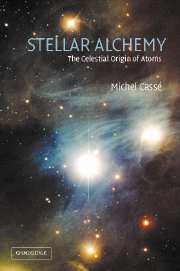Book contents
- Frontmatter
- Contents
- Preface
- Acknowledgements
- 1 Nuclear astrophysics: defence and illustration
- 2 Light from atoms, light from the sky
- 3 Visions
- 4 Contents of the sky: atomic sources and fountains
- 5 Nuclear suns
- 6 Sociology of stars and clouds
- 7 Histories
- 8 Ancient stars in the galactic halo
- 9 Conclusion
- Appendix 1 Invisible matter and energy
- Appendix 2 Supernovas and cosmology
- Appendix 3 Explosions
- Appendix 4 Stellar nucleosynthesis
- Appendix 5 Galactic evolution
- Appendix 6 Key dates
- Appendix 7 Constants and units
- Appendix 8 Websites
- Bibliography
- Index
3 - Visions
- Frontmatter
- Contents
- Preface
- Acknowledgements
- 1 Nuclear astrophysics: defence and illustration
- 2 Light from atoms, light from the sky
- 3 Visions
- 4 Contents of the sky: atomic sources and fountains
- 5 Nuclear suns
- 6 Sociology of stars and clouds
- 7 Histories
- 8 Ancient stars in the galactic halo
- 9 Conclusion
- Appendix 1 Invisible matter and energy
- Appendix 2 Supernovas and cosmology
- Appendix 3 Explosions
- Appendix 4 Stellar nucleosynthesis
- Appendix 5 Galactic evolution
- Appendix 6 Key dates
- Appendix 7 Constants and units
- Appendix 8 Websites
- Bibliography
- Index
Summary
The language of light: equivalence of colour, wavelength and temperature
Unplaiting the braids of light, we discover the colour blue. Weaving together the strands of blue, red and yellow, all are swamped in white. Light thus looks white if it has a similar spectrum to the Sun, and other colours can be described as a divergence from the latter. However, the word ‘colour’ is not precise enough to qualify this attribute of light. Of course, scientifically, each note of light, each elementary tone of green, yellow, crimson, mauve or any other hue, is designated a number called wavelength. The tints of light are thus quantified, each assigned its corresponding wavelength. Blue is just a length, expressed by a number (roughly 500 nm), and likewise yellow (around 600 nm) and red (650 nm). So yellow lies between blue and red, and that is all there is to it!
On extragalactic and cosmological scales, light is reddened by the receding motion of its source. The further the source, the faster it appears to move away and the more the source is reddened. However, distance across space also goes with remoteness in time and the past of the Universe is tinged with red. Still further back, it even slips into the infrared.
Light is a conscientious messenger, carrying information from one point of the Universe to another. Atoms in stars speak the language of light to atoms in eyes. Why should we move when light can bring this wealth to us?
- Type
- Chapter
- Information
- Stellar AlchemyThe Celestial Origin of Atoms, pp. 17 - 50Publisher: Cambridge University PressPrint publication year: 2003



